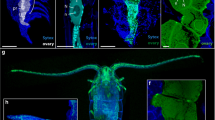Summary
The cleavage pattern of the young sea urchin embryo was studied by means of light and electron microscopy.
The micromeres, which are known to have a strong organizing effect on the embryo, were found to form a syncytium with their neighbouring micromeres and with the macromeres. The cell walls between these cells were observed to be incomplete while there were interphase nuclei with intact nuclear membranes in the micro- and the macromeres. Similar phenomena with a break down of the cell membranes were not observed between macro- and mesomeres while there were intact interphase nuclei in these cells. Micromeres implanted on macromeres or mesomeres were found to coalesce with these latter cells in the course of a few minutes. During interphase, when the nuclei of both micro- and mesomere (macromere) had intact nuclear membranes, there also was a break down of the cell walls and a syncytium was formed by the “host cell” and the implanted micromere (see Fig. 6).
The primary mesenchyme cells, which are regarded as the descendants of the micromeres, were also studied and were likewise found to form true syncytia.
The importance to embryogenesis of this unique formation of syncytia is discussed.
Similar content being viewed by others
References
Agrell, I., 1958: A cytoplasmic production of ribonucleic acid during the cell cycle of the micromeres in the sea urchin embryo. Ark. Zool.11, 435–440.
Berg, W. E., andN. D. Long, 1964: Regional differences of mitochondrial size in the sea urchin embryo. Exp. Cell Res.33, 422–437.
—,D. A. Taylor, andW. J. Humphreys, 1962: Distribution of mitochondria in echinoderm embryos as determined by electron microscopy. Develop. Biol.4, 165–176.
Cowden, R. R., andH. E. Lehman, 1963: A cytochemical study of differentiation in early echinoid development. Growth27, 185–197.
Czihak, G., 1965: Entwicklungsphysiologische Untersuchungen an Echiniden (RibonucleinsÄure-Synthese in den Mikromeren und Entodermdifferenzierung. Ein Beitrag zum Problem der Induktion). Arch. Entwickl.-Mech. Org.156, 504–524.
—, 1966: Entwicklungsphysiologische Untersuchungen an Echiniden (Zerstörung der Mikromeren durch UV-Bestrahlung, ein Beitrag zum Problem der Induktion und Regulation). Arch. Entwickl.-Mech. Org.157, 199–211.
Czihak, G., H. G. Wittmann undI. Hindennach, 1967: Uridineinbau in die NucleinsÄuren von Furchungsstadien der Eier des SeeigelsParacentrotus lividus. Z. Naturforsch.22, 1176–1182.
Gustafson, T., andP. Lenicque, 1952: Studies on mitochondria in the developing sea urchin egg. Exp. Cell Res.3, 251–274.
—, andL. Wolpert, 1961: Studies on the cellular basis of morphogenesis in the sea urchin embryo. Directed movements of primary mesenchyme cells in normal and vegetalized larvae. Exp. Cell Res.24, 64–79.
Hagström, B. E., 1963: The effect of lithium and o-iodosobenzoic acid on the early development of the sea urchin egg. Biol. Bull. Woods Hole124, 55–64.
—, andS. Lönning, 1964: The rate of development in isolated halves of sea urchin embryos. Sarsia15, 17–22.
— —, 1965: Studies of cleavage and development of isolated sea urchin blastomeres. Sarsia18, 1–9.
— —, 1966: Analysis of the effect of dinitrophenol on cleavage and development of the sea urchin embryo. Protoplasma62, 246–254.
— —, 1967: Cytological and morphological studies of the action of lithium on the development of the sea urchin embryo. Arch. Entwickl.-Mech. Org.158, 1–12.
Hagström, Britt, 1955: Studies in the maturation of underripe sea urchin eggs. Exp. Cell Res.9, 313–318.
Hörstadius, S., 1935: über die Determination im Verlaufe der Eiachse bei Seeigeln. Pubbl. Staz. zool. Napoli14, 251–479.
—, 1939: The mechanics of sea urchin development, studied by operative methods. Biol. Rev.14, 132–179.
Karnovsky, M. J., 1961: Simple methods for “staining with lead” at high pH in electron microscopy. J. biophys. biochem. Cytol.11, 729–732.
Kuhl, W., undG. Kuhl, 1949: Neue Ergebnisse zur Cytodynamik der Befruchtung und Furchung des Eies vonPsammechinus miliaris Gmel. Zool. Jb., Abt. Anat. u. Ontog.70, 1–59.
Lindahl, P. E., 1953: On a normally occurring reduction-division in somatic cells of the sea urchin embryo. Exp. Cell Res.5, 416–419.
Okazaki, K., 1960: Skeleton formation of sea urchin larvae. II. Organic matrix of the spicule. Embryologia5, 283–320.
—, 1965: Skeleton formation of sea urchin larvae. V. Continuous observation of the process of matrix formation. Exp. Cell Res.40, 585–596.
Reynolds, S., 1963: The use of lead citrate at high pH as an electron-opaque stain in electron microscopy. J. Cell Biol.17, 208–211.
Shaver, J. R., 1955: The distribution of mitochondria in sea urchin embryos. Experientia11, 351–353.
Théel, H., 1892: On the development ofEchinocyamus pusillus (O. F. Müller). Nova Acta R. Soc. Scient. upsal. Ser. Ill,15 (6), 1–57.
Ubisch, L. von, 1937: Die normale Skelettbildung beiEchinocyamus pusillus undPsammechinus miliaris und die Bedeutung dieser VorgÄnge für die Analyse der Skelette von Keimblatt-ChimÄren. Z. wiss. Zool.149, 402–476.
Wolpert, L., andT. Gustafson, 1961: Studies on the cellular basis of morphogenesis of the sea urchin embryo. Development of the skeletal pattern. Exp. Cell Res.25, 311–325.
Zeuthen, E., 1951: Segmentation, nuclear growth, and cytoplasmic storage in eggs of echinoderms and amphibia. Pubbl. Staz. zool. Napoli23, Suppl. 47–69.
Author information
Authors and Affiliations
Rights and permissions
About this article
Cite this article
Hagström, B.E., Lönning, S. Time-lapse and electron microscopic studies of sea urchin micromeres. Protoplasma 68, 271–288 (1969). https://doi.org/10.1007/BF01251614
Received:
Issue Date:
DOI: https://doi.org/10.1007/BF01251614




